AMD EPYC 7642 Benchmarks
For this exercise, we are using our legacy Linux-Bench scripts which help us see cross-platform “least common denominator” results we have been using for years as well as several results from our updated Linux-Bench2 scripts. Starting with our 2nd Generation Intel Xeon Scalable benchmarks, we are adding a number of our workload testing features to the mix as the next evolution of our platform.
At this point, our benchmarking sessions take days to run and we are generating well over a thousand data points. We are also running workloads for software companies that want to see how their software works on the latest hardware. As a result, this is a small sample of the data we are collecting and can share publicly. Our position is always that we are happy to provide some free data but we also have services to let companies run their own workloads in our lab, such as with our DemoEval service. What we do provide is an extremely controlled environment where we know every step is exactly the same and each run is done in a real-world data center, not a test bench.
We are going to show off a few results, and highlight a number of interesting data points in this article.
Python Linux 4.4.2 Kernel Compile Benchmark
This is one of the most requested benchmarks for STH over the past few years. The task was simple, we have a standard configuration file, the Linux 4.4.2 kernel from kernel.org, and make the standard auto-generated configuration utilizing every thread in the system. We are expressing results in terms of compiles per hour to make the results easier to read:
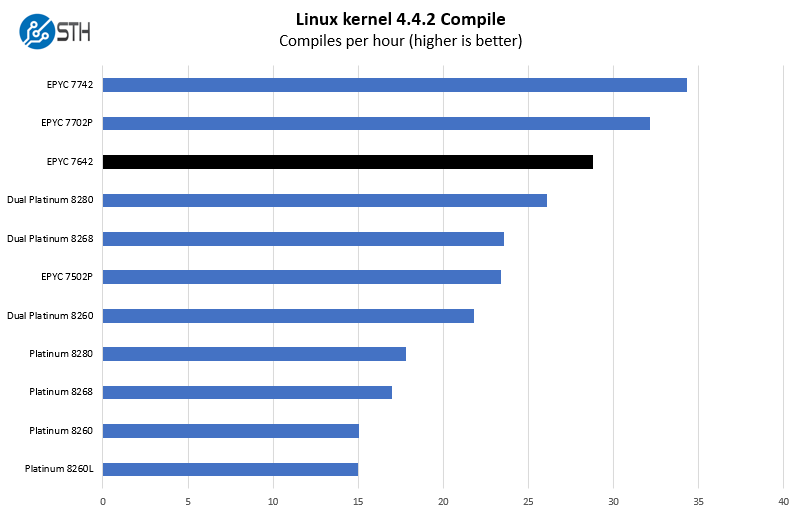
Big caches are really helping performance for AMD here as are having fewer NUMA nodes. AMD did well with its previous generation of EPYC 7001 parts, but architecturally, the newer chips like the AMD EPYC 7642 are simply better. Taking advantage of the architecture means this is one of the best results for the EPYC 7642.
c-ray 1.1 Performance
We have been using c-ray for our performance testing for years now. It is a ray tracing benchmark that is extremely popular to show differences in processors under multi-threaded workloads. We are going to use our 8K results which work well at this end of the performance spectrum.
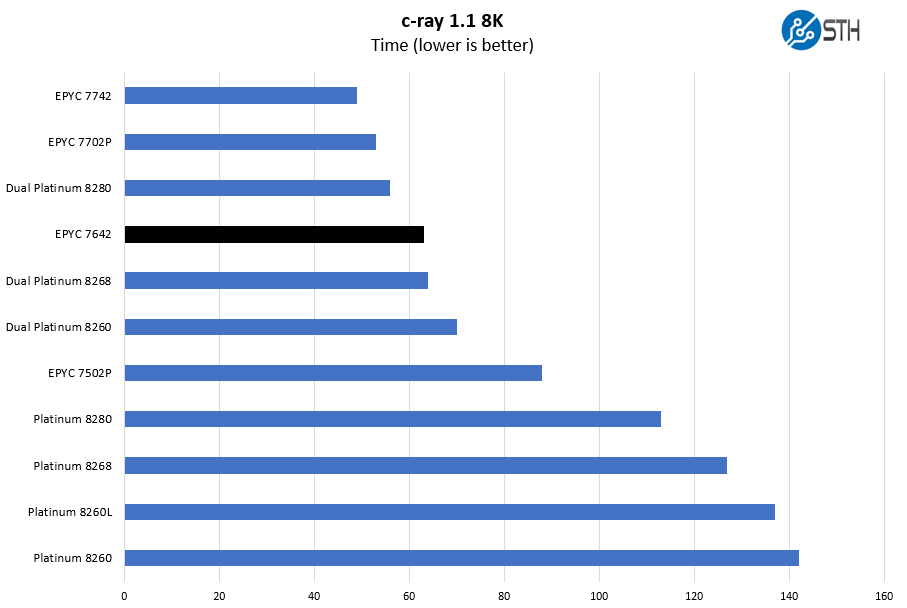
Typically AMD does well here. It may be strange to see a single 48-core CPU sitting almost even with the dual Intel Xeon Platinum 8268, however, they are both 48-core setups. The EPYC 7642 is a single socket and around one third the list price of the Intel solution.
7-zip Compression Performance
7-zip is a widely used compression/ decompression program that works cross-platform. We started using the program during our early days with Windows testing. It is now part of Linux-Bench.
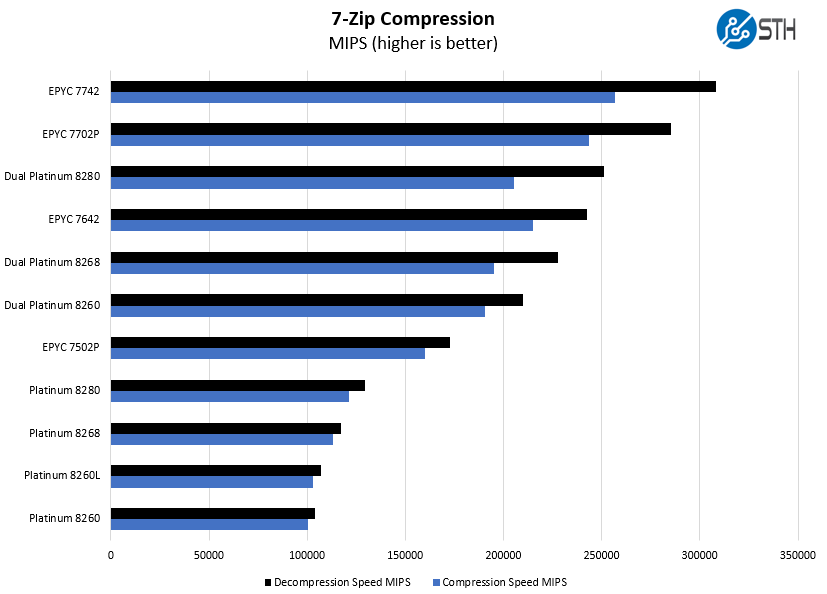
Taking a quick break from the AMD v. Intel offering discussion for a moment, let us look at the AMD offerings. When we are looking at single-socket applications, the AMD EPYC 7502P is a 32-core offering at around half the list price. Moving up the stack, the AMD EPYC 7702P is around the same price. Without a $3300-3500 48-core P part, in most cases, it is hard to recommend the single-socket EPYC 7642 unless you need higher per-core performance. The EPYC 7702P has more compute resources at around the same price. An AMD EPYC 7642P would change that story.
NAMD Performance
NAMD is a molecular modeling benchmark developed by the Theoretical and Computational Biophysics Group in the Beckman Institute for Advanced Science and Technology at the University of Illinois at Urbana-Champaign. More information on the benchmark can be found here. With GROMACS we have been working hard to support AVX-512 and AVX2 supporting AMD Zen architecture. Here are the comparison results for the legacy data set:
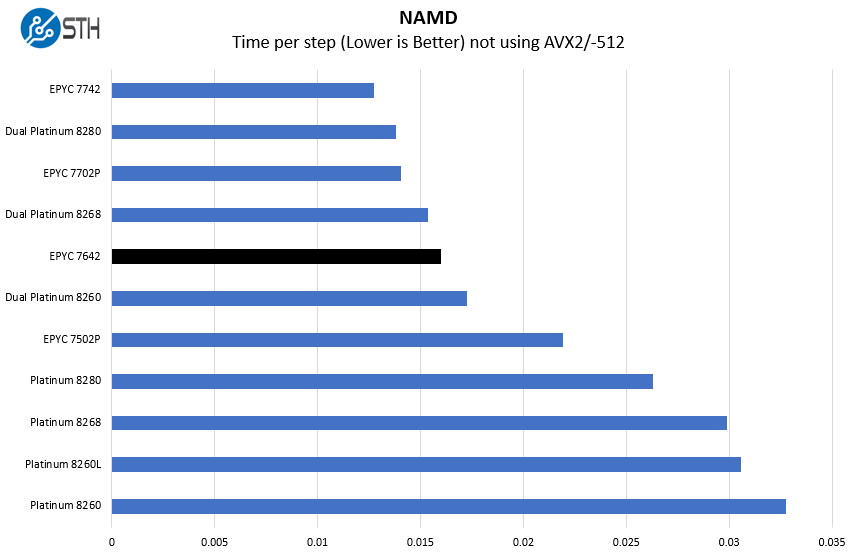
This is essentially code that is scaling to multiple cores but is not optimized for new instructions. A major question we get is what happens if you are using AMD EPYC with existing workloads. We generally advise that if you have a legacy application running in a VM you can move it to an EPYC host, and you will not notice a performance hit. Instead, you are likely to have a bigger pool of resources to work with.
OpenSSL Performance
OpenSSL is widely used to secure communications between servers. This is an important protocol in many server stacks. We first look at our sign tests:
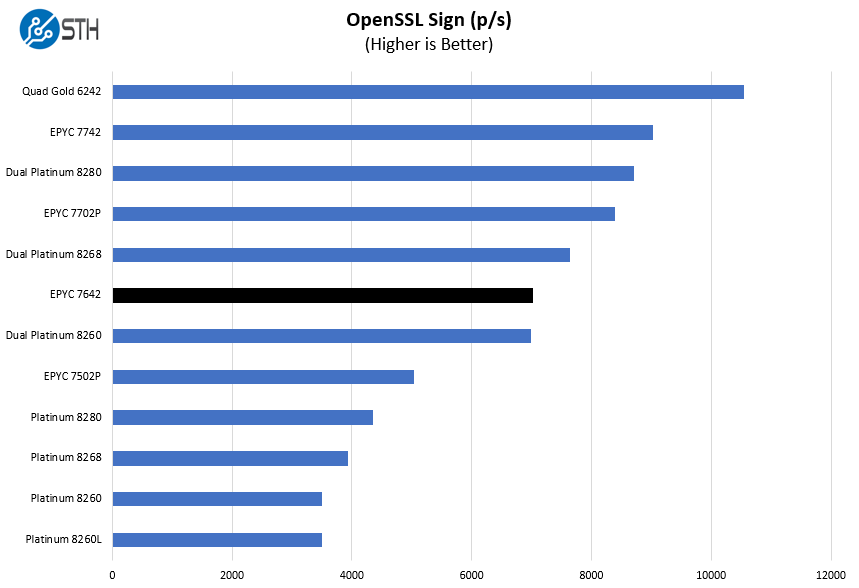
Here are the verify results:
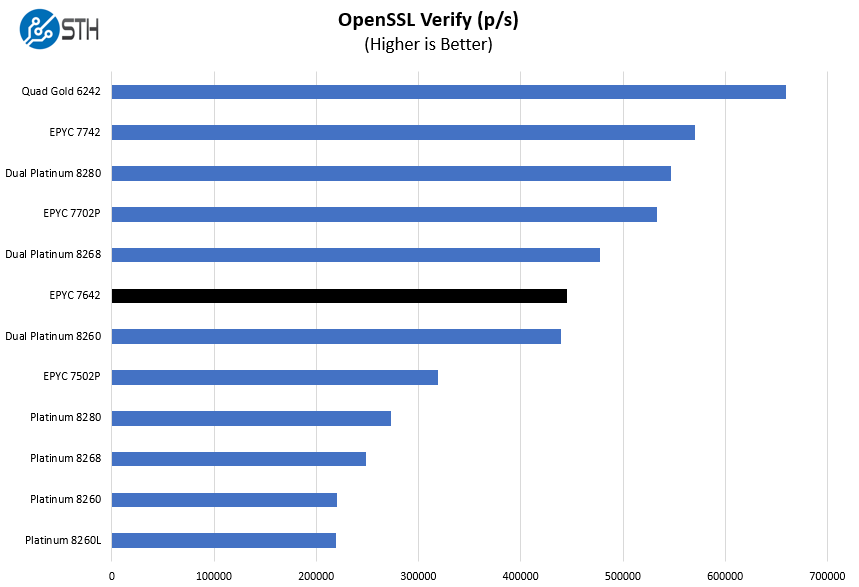
This is one where the dual Intel Xeon Platinum 8268 performs better than the single AMD EPYC 7642. Indeed, here the EPYC 7642 performs just a bit better than the Intel Xeon Platinum 8260.
UnixBench Dhrystone 2 and Whetstone Benchmarks
Some of the longest-running tests at STH are the venerable UnixBench 5.1.3 Dhrystone 2 and Whetstone results. They are certainly aging, however, we constantly get requests for them, and many angry notes when we leave them out. UnixBench is widely used so we are including it in this data set. Here are the Dhrystone 2 results:
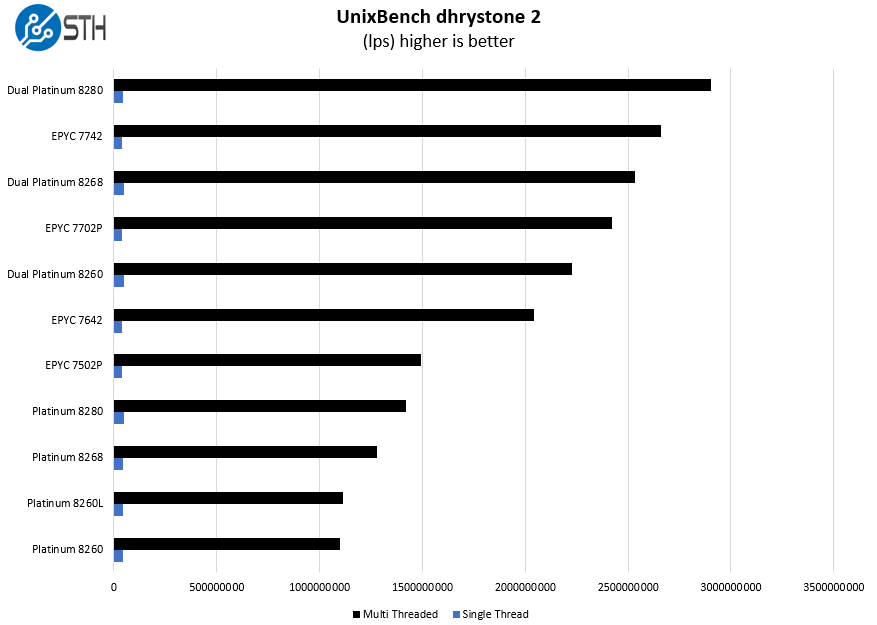
Here are the whetstone results:
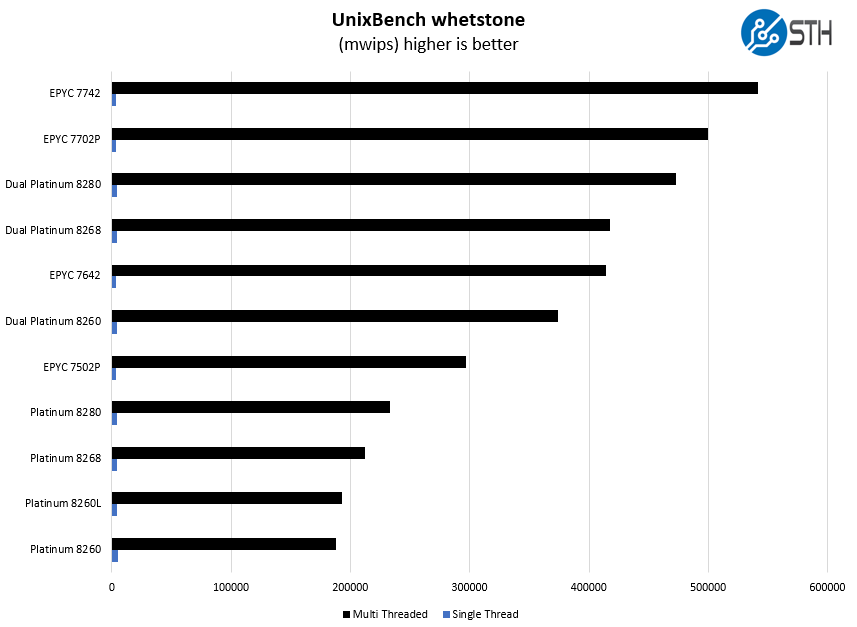
Reading through these charts, you likely noticed that we have been comparing the EPYC 7642 to dual Intel Xeon Platinum SKUs, and realistically the mid to high-end socketed Platinum range.
Chess Benchmarking
Chess is an interesting use case since it has almost unlimited complexity. Over the years, we have received a number of requests to bring back chess benchmarking. We have been profiling systems and are ready to start sharing results:
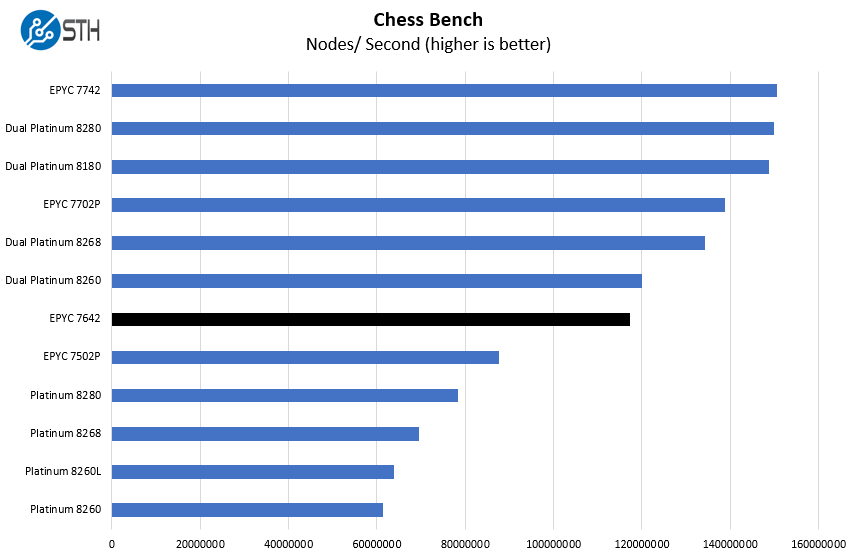
Intel Xeon CPUs do well here. We see the EPYC 7642 fall between the EPYC 7502P and 7702P which is what we would expect.
A Note on Virtualization Testing
Our STH KVM-based virtualization testing has been very successful. We actually had our results in the original copy of this review. We instead are going to re-visit the AMD EPYC 7642 virtualization performance in our dual socket piece. With 48 cores and 256MB of RAM, we reviewed the results and we were primarily RAM limited. The CPU limited test case followed the above set of charts so we did not see much value in adding it here. New sets of RAM are inbound and we are also setting up a quad-socket Intel Xeon Scalable test platform to do more 2P AMD v. 4P Intel comparisons.
Next, we are going to look at the AMD EPYC 7642 market positioning before moving to our final words.




“Instead, with Intel’s 10nm delays this AMD EPYC 7642 is essentially like later next year’s enormous performance jump halo Xeon, except it is available today from AMD and at a lower price.”
I think that’s the first Intel 10nm dig I’ve read on STH. That paragraph was great.
When is it better than 7702P if used in 1cpu servers?
Brian, you must have missed the glued-together cores article. I find Patrick is very fair with his digs on all sides. lol
I almost feel like AMD openned a wormwhole with these EPYCs and processors have leaped a decade into the future. It’s very overwhelming, to the point of almost feeling unreal.
But I am still with Intel, unfortunately. I have more choices of dual socket motherboards, can easily get a pair of cheap 8280L or 8276L QS (nah, no ES thx) CPUs and build my “poorman” home lab servers, and later when those parts have great price drops I can replace those CPUs with proper released version. So EPYC looks good, but the price and current choice limitations also look “Epic” to me. BTW I don’t need PCIe 4.0 for now – I am still trying hard to saturate all my available PCIe 3 (96) lanes per server. That’s about 80GBytes/s of data bidirectional in real life I think? And I have 2 servers…Well, when I say “cheap”, each CPU is actually cheaper than the motherboard…you get the idea…